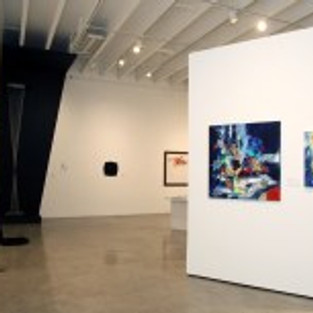Breaking Illusions: Artist as Scientist at Claremont Graduate University
- artandcakela
- Feb 9, 2018
- 3 min read

Clara Berta and Alice Marie Perrault. Artist as Scientist, Claremont Graduate University Art Building; Photo Credit: Jill Carol
Breaking Illusions: Artist as Scientist
Claremont Graduate University’s Peggy Phelps and East Galleries, Claremont
By Jacqueline Bell Johnson It is a growing trend for art and science to be paired together: usually from a scientific and technological standpoint. But it is less often discussed within fine art, especially without the accompaniment of some qualifier, like education. The exhibition, “Breaking Illusions: Artist as Scientist” addresses the topic head-on from the fine art context. The artists and work in this show encapsulate the artist’s process as a scientific one, perhaps just using a different rubric. The artwork created is the outcome (sometimes even the displayed results) of rigorous methodologies that occur in the studio — experimenting, hypothesizing, theorizing, observing, measuring, interpreting results. The results are aesthetically mesmerizing and intellectually intriguing.
Here are some highlights: Annie Clavel’s paintings depict an understanding of the birth of structure: force, energy, and matter collide on the surface of her canvas in a glorious polychrome. The momentum is captured in rich layers of paint depicting explosive forms in centric compositions.
A sculpture made of a 3D printed mountain-like object, concrete, LED lights, and sound by Emery C. Martin is a visual interpretation of data. The high-tech aesthetic is not just in presentation: Martin created software to specifically formulate information into form.
Betsy Lohrer Hall’s installation of paper, paint and thread is a study in the variety of marks possible from a single technique. To work with materials is to know its behavior, learning its abilities and weaknesses. Lohrer Hall’s ritualistic procedure teaches her these nuances. The installation therein is her logbook, notes she is sharing with the viewer of her discoveries.
Kimiko Myoshi’s mirrored mylar works are enchanting. The viewer’s reflection is foggy and obscured yet still recognizable at a distance. Moving in, one notices delicate cuts have been made into the surface, at first appearing as patterns, then growing into images of catastrophe of which the viewer is now a part of.
Virginia Katz’ paintings are in fact miniature landscapes. Paint is used as both color and substance, emerging as topography inspired by the Californian landscape. These paintings lay flat on pedestals and behave as surreal geographic models giving the viewer a bird’s eye vantage.
Having worked with NASA at their Chanda Wilson Observatory as well as with Harvard-Smithsonian’s team of Astrophysicists, Melissa Walter has had the opportunity to study and visually interpret celestial bodies. Her stark, black works offer a dramatic contrast to the gallery’s white walls. Ordinary materials placed into elegant formation make graspable the provocative wonders of deep space.
Eric Johnson’s sculptures are experiments in building form. The works feel not like a light and airy gesture of the figure, but meaty and honest. A wooden structure peeks through layers of colored milky resin. The surface is finished smooth, exposing the skeleton and therefore the process underneath.
“Breaking Illusions: Artist as Scientist” was curated by Conchi Sanford and on exhibit at Claremont Graduate University’s Peggy Phelps and East Galleries from January 15 to February 2, 2018.
Exhibiting Artists: Alice Marie Perreault, Annie Clavel, Betsy Lohrer Hall, Clara Berta, Dianna Lindquist, Eric Johnson, Emery C. Martin, Jessica Wimbley, Kimiko Miyoshi, Melissa Walter, Patrick Faulk, Randi Hokett, and Virginia Katz.
Claremont Graduate University’s Peggy Phelps and East Galleries 251 E. 10th St, Claremont, CA 91711 www.cgu.edu
#losangeles #california #celestial #losangelesartist #JessicaWimbley #art #painting #3Dprinting #claremont #physics #losangelesart #contemporaryart #PatrickFaulk #southerncalifornia #artistrunspace #abstract #collage #peggyphelpsgallery #AnnieClavel #photography #artgallery #astronomy #gallery #science #KimikoMiyoshi #randihokett #technology #artasscience #artandcake #artopening #EmeryCMartin #virginiakatz #MelissaWalter #assemblage #artexhibition #BetsyLohrerHall #AliceMariePerreault #ArtandCakeLA #fineart #artists #conchisanford #artist #mixedmedia #arts #EricJohnson #environment #artreview #sculpture #artmagazine #artcollective #DiannaLindquist #ArtandCulture #exhibition #EastGallery #exhibit #JacquelineBellJohnson #ClaraBerta #ClaremontGraduateUniversity #drawing












































































